动词的ed和ing形式
动词-ed和动词-ing用法怎么用

动词-ed和动词-ing用法怎么用动词-ed和动词-ing用法怎么用1、定义动词-ed和动词-ing形式常称作分词。
他们既有动词的特征,又有形容词和副词的特征,在英语中可以作定语、状语、表语和宾语补足语。
2、构成(1)规则的动词后+ed构成动词-ed形式,不规则的需要记忆。
动词-ed形式没有一般式和完成式、主动语态和被动语态的变化。
(2)动词-ing形式有一般式和完成式、主动语态和被动语态区别。
下列以及物动词write和不及物动词go列表示例:writego主动被动动词-ing一般式 writing being written going动词-ing完成式 having written having been written动词-ed written gone3、用法(1)作定语单个的分词作定语,一般置于所修饰的词前;分词短语作定语置于所修饰的词后,相当于一个定语从句。
如:Many excited people wanted to travel on the underground.许多兴奋的人们想乘地铁旅行。
The countries you referred to just now belong to developing countries.你刚才提到的那些国家属于发展中国家。
People developed a kind of paper made from the fibers of plants.=People developed a kind of paper which/that was madefrom the fibers of plants.人们研制出一种用植物纤维制成的纸。
The houses being built are for the teachers.=The houses which/that are being built are for the teachers.正在(被)建的那些房子是给老师们的。
非谓语动词(动词ing形式和动词ed形式)课件
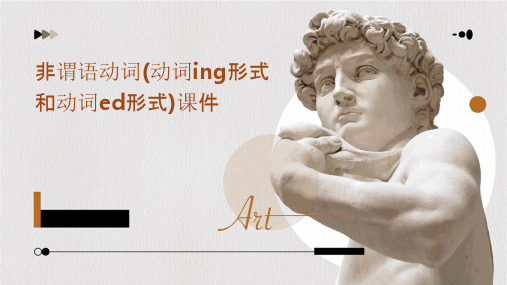
03
Hale Waihona Puke 动词ed形式可以作为状 语,表示动作发生的时 间、原因、条件等。
04
例如:He was born in 1990.(他出生于1990 年。)
动词ed形式与分词的区别
动词ed形式与分词在语法功能和用法 上存在显著差异。
例如:I have seen the movie.(我 已经看过这部电影了。)(动词ed形 式)
动词ing形式表示正在进行的动作或行为,而动名词表示已经完成或结果的状态。
动词ing形式在句子中做主语或表语时,表示一个动作或行为,而动名词则表示一个 名词概念。
03 动词ed形式
动词ed形式的构成
动词ed形式由动词原形加-ed构成,规则动词的-ed形式一般直接在词尾加-ed。 例如:work -> worked,play -> played。
表示被动关系
如"The book was written by him."。
表示习惯或经常性的行为
如"He likes reading books."。
表示时间或条件状语
如"If you study hard, you will succeed."。
动词ing形式与动名词的区别
动词ing形式既可以作为谓语的一部分,也可以作为独立成分,而动名词只能作为谓 语的宾语或表语。
非谓语动词的语态
主动语态
表示非谓语动词所表示的动作是 由句子主语发出来的。
被动语态
表示非谓语动词所表示的动作不 是由句子主语发出来的,而是被 其他人或物完成的。
非谓语动词时态和语态的用法
过去分词可以用于描述已经完成 的动作或存在的状态,常与时间 状语连用,如“已经”、“已经 完成”、“已经达到”等。
动词-ed形式和-ing形式区别

动词-ed 形式与-ing 形式的区别-ing 形式表示主动的意义,-ed形式表示被动的意义-ing 形式表示一般性的或正在进行的动作,-ed 形式表示已经完成和被动的动作在表现形式上,-ing形式有“一般式”和“完成式”之分,而-ed形式只有一种形式1.动词-ing形式在句中可用作主语或宾语,而-ed形式则不能2.作表语的区别动词-ing形式具有主动和进行的含义,经常用于表示事物的性质,“使人…”或“令人…”,而动词-ed形式含有被动意思,经常用来说明“某人感觉…”What he said was encouraging .We were encouraged at what he said .3.作定语的区别⑴.语态不同:-ing 表示主动意思,动词-ed 表示被动意思Surprising news = news which surprises people Surprised people =people who are surprised⑵.时间不同:-ing表示动作正在进行,-ed 表示动作已经完成Boiling water 正在沸腾的水Boiled water 已经烧开的水4.作宾语补足语的区别⑴.语态不同:及物动词的-ed形式作宾语补足语时,表示被动,说明宾语是-ed形式动作的承受者,而-ing形式作宾语补足语时,表示主动,说明宾语是补足语的动作的执行者.I often hear the song sung in EnglishI often hear people singing the song.⑵.时间不同;有些动词-ed形式作宾语补足语时,常表示动作已经完成或动作发生在谓语动词之前,-ing形式作宾语补足语时,则表示动作正在进行When I got home , I found my wallet lostWhen I came here ,I found Wanglei reading an English book.。
英语语法解析 动词-ing形式与动词-ed形式的区别
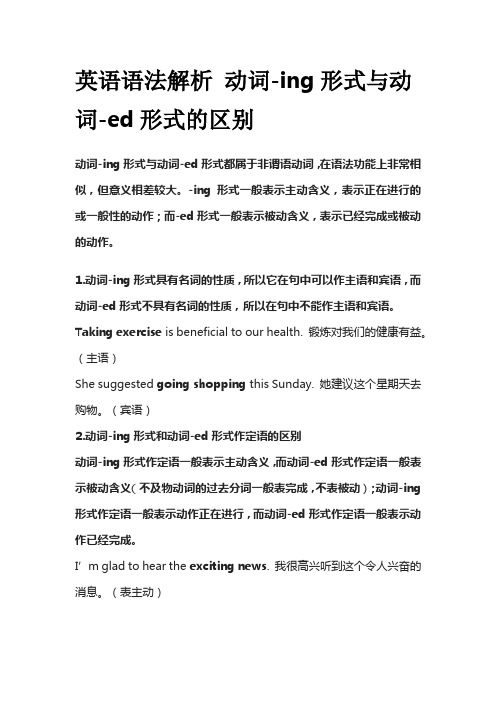
英语语法解析动词-ing形式与动词-ed形式的区别动词-ing形式与动词-ed形式都属于非谓语动词,在语法功能上非常相似,但意义相差较大。
-ing形式一般表示主动含义,表示正在进行的或一般性的动作;而-ed形式一般表示被动含义,表示已经完成或被动的动作。
1.动词-ing形式具有名词的性质,所以它在句中可以作主语和宾语,而动词-ed形式不具有名词的性质,所以在句中不能作主语和宾语。
Taking exercise is beneficial to our health. 锻炼对我们的健康有益。
(主语)She suggested going shopping this Sunday. 她建议这个星期天去购物。
(宾语)2.动词-ing形式和动词-ed形式作定语的区别动词-ing形式作定语一般表示主动含义,而动词-ed形式作定语一般表示被动含义(不及物动词的过去分词一般表完成,不表被动);动词-ing 形式作定语一般表示动作正在进行,而动词-ed形式作定语一般表示动作已经完成。
I’m glad to hear the exciting news. 我很高兴听到这个令人兴奋的消息。
(表主动)The cat drawn by the boy was very lovely. 男孩画的猫非常可爱。
(表被动)The ground was covered fallen leaves. 地上覆盖着落叶。
(不及物动词表完成)The rising sun is a symbol of hope. 冉冉升起的太阳象征着希望。
(表动作正在进行)They looked up at the risen sun. 他们仰望着已升起的太阳。
(表动作完成)3.动词-ing形式和动词-ed形式作表语的区别动词-ing形式作表语一般表示主语的性质和特征,含义为“令人……”;动词-ed形式作表语一般表示人的感受,含义为“(某人)感觉……”。
动词加ed和ing规则
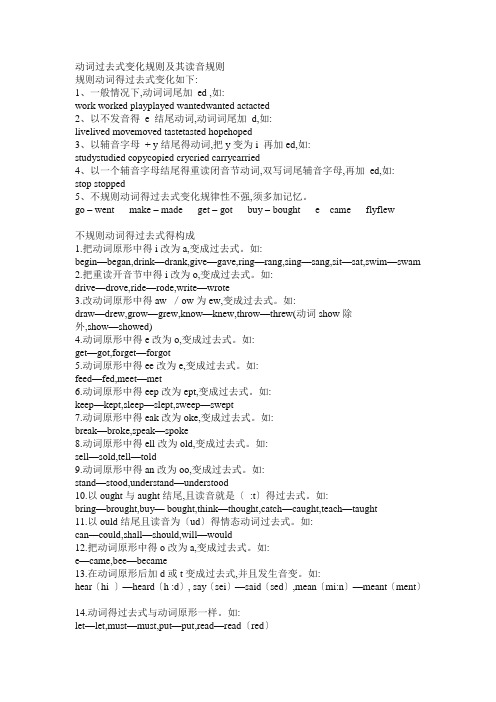
动词过去式变化规则及其读音规则规则动词得过去式变化如下:1、一般情况下,动词词尾加ed ,如:work worked playplayed wantedwanted actacted2、以不发音得e 结尾动词,动词词尾加d,如:livelived movemoved tastetasted hopehoped3、以辅音字母+ y结尾得动词,把y变为i 再加ed,如:studystudied copycopied crycried carrycarried4、以一个辅音字母结尾得重读闭音节动词,双写词尾辅音字母,再加ed,如:stop stopped5、不规则动词得过去式变化规律性不强,须多加记忆。
go – went make – made get – got buy – bought e came flyflew不规则动词得过去式得构成1.把动词原形中得i改为a,变成过去式。
如:begin—began,drink—drank,give—gave,ring—rang,sing—sang,sit—sat,swim—swam 2.把重读开音节中得i改为o,变成过去式。
如:drive—drove,ride—rode,write—wrote3.改动词原形中得aw /ow为ew,变成过去式。
如:draw—drew,grow—grew,know—knew,throw—threw(动词show除外,show—showed)4.动词原形中得e改为o,变成过去式。
如:get—got,forget—forgot5.动词原形中得ee改为e,变成过去式。
如:feed—fed,meet—met6.动词原形中得eep改为ept,变成过去式。
如:keep—kept,sleep—slept,sweep—swept7.动词原形中得eak改为oke,变成过去式。
如:break—broke,speak—spoke8.动词原形中得ell改为old,变成过去式。
动词ing和动词ed的用法

动词ing和动词ed的用法动词ing和动词ed是英语中常见的两种动词形式。
它们在句子中的用法和含义有所不同,下面将详细介绍它们的用法。
首先,动词ing形式通常表示正在进行或持续进行的动作。
例如,"I am studying for my exam."(我正在为考试而学习。
)这里的"studying"表示正在进行的动作。
另外,动词ing形式还可以用作名词,表示一种活动或状态。
例如,"Swimming is my favorite sport."(游泳是我最喜欢的运动。
)这里的"swimming"表示一种活动。
其次,动词ed形式通常表示已经完成的动作或状态。
例如,"I have finished my homework."(我已经完成了作业。
)这里的"finished"表示已经完成的动作。
另外,动词ed形式还可以用作形容词,表示被动或描述性质。
例如,"I am interested in the book."(我对这本书感兴趣。
)这里的"interested"表示被动或描述性质。
此外,动词ing和动词ed形式还可以用作动词的补语。
动词ing形式作为补语时,通常表示主语的状态或感受。
例如,"I am happy."(我很快乐。
)这里的"happy"表示主语的状态。
动词ed形式作为补语时,通常表示主语的感受或经历。
例如,"I am excited about the trip."(我对这次旅行感到兴奋。
)这里的"excited"表示主语的感受。
此外,动词ing和动词ed形式还可以用作动词的宾语。
动词ing形式作为宾语时,通常表示动作的对象或目标。
例如,"I enjoy reading books."(我喜欢读书。
动词加ed和ing规则

动词过去式变化规则及其读音规则规则动词的过去式变化如下:1、一般情况下,动词词尾加-ed ,如:work ---worked play---play ed wanted----wanted act----acted2、以不发音的-e 结尾动词,动词词尾加-d,如:liv e---liv ed mov e----mov ed taste---tasted hope---hoped3、以辅音字母+ y结尾的动词,把-y变为-i 再加-ed,如:study---studied copy---copied cry---cried carry---carried4、以一个辅音字母结尾的重读闭音节动词,双写词尾辅音字母,再加-ed,如:stop ---stopped5、不规则动词的过去式变化规律性不强,须多加记忆。
go – went make – made get – got buy - bought come - came f ly-flew不规则动词的过去式的构成1.把动词原形中的i改为a,变成过去式。
如:begin—began,drink—drank,giv e—gav e,ring—rang,sing—sang,sit—sat,swim—swam 2.把重读开音节中的i改为o,变成过去式。
如:driv e—drov e,ride—rode,write—wrote3.改动词原形中的aw /ow为ew,变成过去式。
如:draw—drew,grow—grew,know—knew,throw—threw(动词show除外,show—showed)4.动词原形中的e改为o,变成过去式。
如:get—got,f orget—f orgot5.动词原形中的ee改为e,变成过去式。
如:f eed—f ed,meet—met6.动词原形中的eep改为ept,变成过去式。
如:keep—kept,sleep—slept,s weep—swept7.动词原形中的eak改为oke,变成过去式。
动词后加-ed -ing的规则
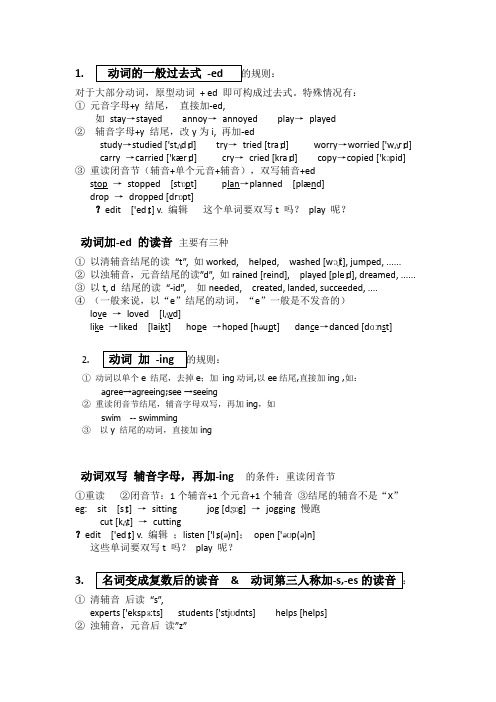
1.对于大部分动词,原型动词+ ed 即可构成过去式。
特殊情况有:①元音字母+y 结尾,直接加-ed,如stay→stayed annoy→annoyed play→played②辅音字母+y 结尾,改y为i, 再加-edstudy→studied ['stʌdɪd] try→tried [traɪd] worry→worried ['wʌrɪd] carry →carried ['kærɪd] cry→cried [kraɪd] copy→copied ['kɔpid] ③重读闭音节(辅音+单个元音+辅音),双写辅音+edstop →stopped [stɒpt] plan→planned [plænd]drop →dropped [drɒpt]?edit ['edɪt] v. 编辑这个单词要双写t 吗?play 呢?动词加-ed 的读音主要有三种①以清辅音结尾的读“t”, 如worked, helped, washed [wɔʃt], jumped, ......②以浊辅音,元音结尾的读”d”, 如rained [reind], played [pleɪd], dreamed, ......③以t, d 结尾的读“-id”, 如needed, created, landed, succeeded, ....④(一般来说,以“e”结尾的动词,“e”一般是不发音的)love →loved [lʌvd]like →liked [laikt] hope →hoped [həupt] dance→danced [dɑːnst]①动词以单个e 结尾,去掉e;加ing动词,以ee结尾,直接加ing ,如:agree→agreeing;see →seeing②重读闭音节结尾,辅音字母双写,再加ing,如swim -- swimming③以y 结尾的动词,直接加ing动词双写辅音字母,再加-ing 的条件:重读闭音节①重读②闭音节:1个辅音+1个元音+1个辅音③结尾的辅音不是“X”eg: sit [sɪt] →sitting jog [dʒɒg] →jogging 慢跑cut [kʌt] →cutting?edit ['edɪt] v. 编辑;listen ['lɪs(ə)n];open ['əʊp(ə)n]这些单词要双写t 吗?play 呢?3.①清辅音后读“s”,experts ['ekspɜ:ts] students ['stjʊdnts] helps [helps]②浊辅音,元音后读”z”beds [bedz] trees [triz] methods ['meθəds] plays [pleɪz]附录:轻辅音:[p] [t] [ k] [s] [∫] [t∫] [f] [θ] [ts] [tr] [h] 浊辅音:[b] [d] [g] [z] [ʒ] [dʒ] [v] [ð] [dz] [dr] [r] 其他辅音:[m] [n] [ŋ] [w] [ j] [l]。
职称英语考试技巧------动词-ed形式&-ing形式
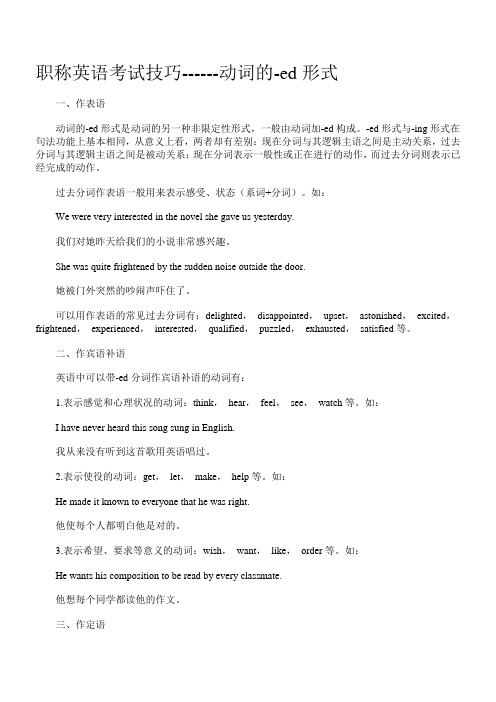
职称英语考试技巧------动词的-ed形式一、作表语动词的-ed形式是动词的另一种非限定性形式,一般由动词加-ed构成。
-ed形式与-ing形式在句法功能上基本相同,从意义上看,两者却有差别:现在分词与其逻辑主语之间是主动关系,过去分词与其逻辑主语之间是被动关系;现在分词表示一般性或正在进行的动作,而过去分词则表示已经完成的动作。
过去分词作表语一般用来表示感受、状态(系词+分词)。
如:We were very interested in the novel she gave us yesterday.我们对她昨天给我们的小说非常感兴趣。
She was quite frightened by the sudden noise outside the door.她被门外突然的吵闹声吓住了。
可以用作表语的常见过去分词有:delighted,disappointed,upset,astonished,excited,frightened,experienced,interested,qualified,puzzled,exhausted,satisfied等。
二、作宾语补语英语中可以带-ed分词作宾语补语的动词有:1.表示感觉和心理状况的动词:think,hear,feel,see,watch等。
如:I have never heard this song sung in English.我从来没有听到这首歌用英语唱过。
2.表示使役的动词:get,let,make,help等。
如:He made it known to everyone that he was right.他使每个人都明白他是对的。
3.表示希望、要求等意义的动词:wish,want,like,order等。
如:He wants his composition to be read by every classmate.他想每个同学都读他的作文。
动词加ed和ing规则汇总情况

动词过去式变化规则及其读音规则规则动词的过去式变化如下:1、一般情况下,动词词尾加 -ed ,如:work ---worked play---played wanted----wanted act----acted2、以不发音的 -e 结尾动词,动词词尾加 -d,如:live---lived move----moved taste---tasted hope---hoped3、以辅音字母 + y结尾的动词,把-y变为-i 再加-ed,如:study---studied copy---copied cry---cried carry---carried4、以一个辅音字母结尾的重读闭音节动词,双写词尾辅音字母,再加 -ed,如:stop ---stopped5、不规则动词的过去式变化规律性不强,须多加记忆。
go – went make – made get – got buy – bought come - came fly-flew不规则动词的过去式的构成1.把动词原形中的i改为a,变成过去式。
如:begin—began,drink—drank,give—gave,ring—rang,sing—sang,sit—sat,swim—swam2.把重读开音节中的i改为o,变成过去式。
如:drive—drove,ride—rode,write—wrote3.改动词原形中的aw /ow为ew,变成过去式。
如:draw—drew,grow—grew,know—knew,throw—threw(动词show除外,show —showed)4.动词原形中的e改为o,变成过去式。
如:get—got,forget—forgot5.动词原形中的ee改为e,变成过去式。
如:feed—fed,meet—met6.动词原形中的eep改为ept,变成过去式。
如:keep—kept,sleep—slept,sweep—swept7.动词原形中的eak改为oke,变成过去式。
动词-ed形式和-ing形式区别

-ing形式表示主动的意义,-ed形式表示被动的意义-ing形式表示一般性的或正在进行的动作,-ed形式表示已经完成和被动的动作在表现形式上,-ing形式有“一般式”和“完成式”之分,而-ed形式只有一种形式1.动词-ing形式在句中可用作主语或宾语,而-ed形式则不能2.作表语的区别动词-ing形式具有主动和进行的含义,经常用于表示事物的性质,“使人…”或“令人…”,而动词-ed形式含有被动意思,经常用来说明“某人感觉…”What he said was encouraging .We were encouraged at what he said .3.作定语的区别⑴.语态不同:-ing表示主动意思,动词-ed表示被动意思Surprising news = news which surprises peopleSurprised people =people who are surprised⑵.时间不同:-ing表示动作正在进行,-ed表示动作已经完成Boiling water正在沸腾的水Boiled water已经烧开的水⑴.语态不同:及物动词的-ed形式作宾语补足语时,表示被动,说明宾语是-ed形式动作的承受者,而-ing形式作宾语补足语时,表示主动,说明宾语是补足语的动作的执行者.I often hear the song sung in EnglishI often hear people sing the song.⑵.时间不同;有些动词-ed形式作宾语补足语时,常表示动作已经完成或动作发生在谓语动词之前,-ing形式作宾语补足语时,则表示动作正在进行When I got home , I found my wallet lostWhen I came here ,I found Wanglei reading anEnglish book.。
非谓语动词 动词 ing形式和动词 ed 形式

7.心理状态动词的-ing形式与-ed形式 所谓心理状态动词是指含有使动意义,使人产生某种情
感、心理变化的动词。例如:surprise使惊讶;interest使感 兴趣。它们的-ing形式含主动意义,-ed形式含被动意义。 皆可视为形容词。例如:surprising令人惊讶的;interesting 令 人 感 兴 趣 的 ; surprised ( 因 …… ) 感 到 惊 讶 的 ; interested(因……)感兴趣的。下面的句子可显示两者的 区别: The film is so interesting that they are all interested in it. She was much surprised at the surprising news.
2. ___C___by the advances in technology, many farmers have
set up wind farms on their land.
A. Being encouraged
B. Encouraging
C. Encouraged源自D. Having encouraged
的完成式表示发生在谓语动词suggested之前的 一个动作,由
句意可知不合题意。
5. 作状语: ①时间状语:Reading the letter, I couldn’t help thinking
of my school life. ②原因状语:Being ill, I didn’t go to school yesterday. ③方式或伴随状语:Mary stood at the school gate waiting
making
being made
(完整版)动词-ed形式和-ing形式区别
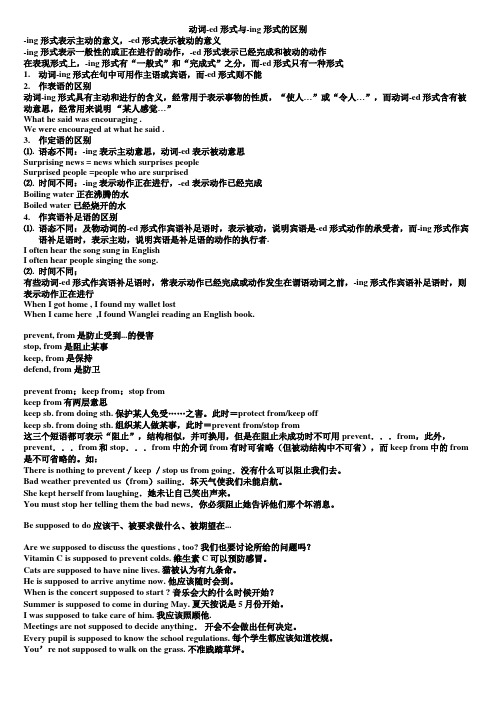
动词-ed 形式与-ing 形式的区别-ing 形式表示主动的意义,-ed形式表示被动的意义-ing 形式表示一般性的或正在进行的动作,-ed 形式表示已经完成和被动的动作在表现形式上,-ing形式有“一般式”和“完成式”之分,而-ed形式只有一种形式1.动词-ing形式在句中可用作主语或宾语,而-ed形式则不能2.作表语的区别动词-ing形式具有主动和进行的含义,经常用于表示事物的性质,“使人…”或“令人…”,而动词-ed形式含有被动意思,经常用来说明“某人感觉…”What he said was encouraging .We were encouraged at what he said .3.作定语的区别⑴.语态不同:-ing 表示主动意思,动词-ed 表示被动意思Surprising news = news which surprises peopleSurprised people =people who are surprised⑵.时间不同:-ing表示动作正在进行,-ed 表示动作已经完成Boiling water 正在沸腾的水Boiled water 已经烧开的水4.作宾语补足语的区别⑴.语态不同:及物动词的-ed形式作宾语补足语时,表示被动,说明宾语是-ed形式动作的承受者,而-ing形式作宾语补足语时,表示主动,说明宾语是补足语的动作的执行者.I often hear the song sung in EnglishI often hear people singing the song.⑵.时间不同;有些动词-ed形式作宾语补足语时,常表示动作已经完成或动作发生在谓语动词之前,-ing形式作宾语补足语时,则表示动作正在进行When I got home , I found my wallet lostWhen I came here ,I found Wanglei reading an English book.prevent, from是防止受到...的侵害stop, from 是阻止某事keep, from 是保持defend, from 是防卫prevent from;keep from;stop fromkeep from有两层意思keep sb. from doing sth. 保护某人免受……之害。
动词加ed和ing规则

动词加ed和ing规则动词过去式变化规则及其读音规则规则动词的过去式变化如下:1、一般情况下,动词词尾加 -ed ,如:work ---worked play---played wanted----wanted act----acted2、以不发音的 -e 结尾动词,动词词尾加 -d,如:live---lived move----moved taste---tasted hope---hoped3、以辅音字母 + y结尾的动词,把-y变为-i 再加-ed,如:study---studied copy---copied cry---cried carry---carried4、以一个辅音字母结尾的重读闭音节动词,双写词尾辅音字母,再加 -ed,如: stop ---stopped5、不规则动词的过去式变化规律性不强,须多加记忆。
go �C went make �C made get �C got buy - bought come - came fly-flew 不规则动词的过去式的构成1.把动词原形中的i改为a,变成过去式。
如:begin―began,drink―drank,give―gave,ring―rang,sing―sang,sit―sat,swim―swam2.把重读开音节中的i改为o,变成过去式。
如:drive―drove,ride―rode,write―wrote3.改动词原形中的aw /ow为ew,变成过去式。
如:draw―drew,grow―grew,know―knew,throw―threw(动词show除外,show―showed)4.动词原形中的e改为o,变成过去式。
如:get―got,forget―forgot5.动词原形中的ee改为e,变成过去式。
如:feed―fed,meet―met6.动词原形中的eep改为ept,变成过去式。
如:keep―kept,sleep―slept,sweep―swept7.动词原形中的eak改为oke,变成过去式。
动词的ing或ed形式做定语讲解与练习总结

用作定语时,动词的-ing形式既包括动名词又包括现在分词, 动词的-ed形式仅是动词过去分词。
动词的-ing形式做定语在句中通常有两个位置,如果是单个的动词的-ing形式做定语,常放在被修饰词前做前置定语;如果是动词的-ing形式的短语做定语,常放在被修饰词后做后置定语。
如:1.He is an attacking player.他是一个攻击型的运发动。
(表示运发动的特征)2.He asked an embarrassing question.他提了一个令人难堪的问题。
(表示“令人….〞)3.A little child learning to walk often falls.学走路的小孩常常跌跤。
(表示被修饰词的动作或状态,动词短语后置)4.Do you know the number of people coming to the party你知道来参加晚会的人数吗(表示被修饰词的动作或状态,动词短语后置)注意:当-ing形式做后置定语时,可以相当于相应的定语从句。
如:1.A young man writing novels came to speak to us yesterday.→A young man who writes novels came to speak to us yesterday.一位写小说的青年昨天来向我们作报告。
2.The girl sitting next to me was my cousin.→The girl who was sitting next to me was my cousin.坐在我旁边的姑娘是我表妹。
另外需要注意的是上面做定语的动词-ing形式表示的动作是正在进展的工作或习惯性的动作,如果和主句谓语的动作不能同时发生时,那么不能用-ing形式做定语而必须用定语从句形式。
如:昨天来我们学校的那位教授在明天给我们做报告。
3.The professor who came to our school yesterday will give us a lecture tomorrow.不正确的表述:The professor coming to our school yesterday will give us a lecture tomorrow.总结:-ing形式做定语通常从以下三方面考察,即:1)说明被修饰词的性质,特征或用途。
动词ed和ing形式做定语
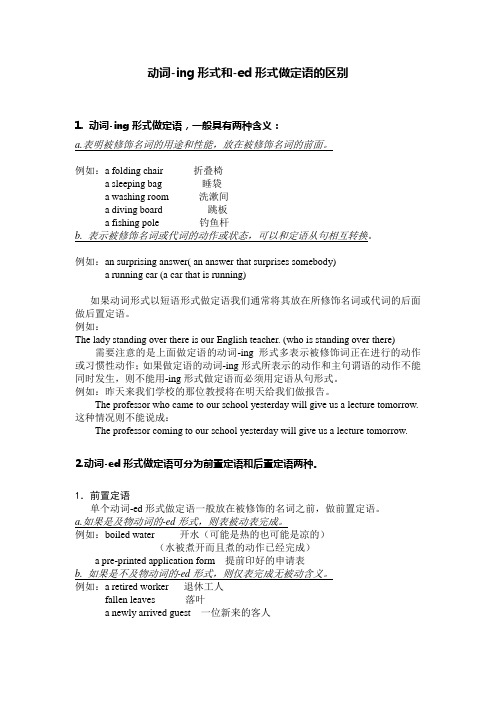
动词-ing形式和-ed形式做定语的区别1. 动词-ing形式做定语,一般具有两种含义:a.表明被修饰名词的用途和性能,放在被修饰名词的前面。
例如:a folding chair 折叠椅a sleeping bag 睡袋a washing room 洗漱间a diving board 跳板a fishing pole 钓鱼杆b. 表示被修饰名词或代词的动作或状态,可以和定语从句相互转换。
例如:an surprising answer( an answer that surprises somebody)a running car (a car that is running)如果动词形式以短语形式做定语我们通常将其放在所修饰名词或代词的后面做后置定语。
例如:The lady standing over there is our English teacher. (who is standing over there) 需要注意的是上面做定语的动词-ing形式多表示被修饰词正在进行的动作或习惯性动作;如果做定语的动词-ing形式所表示的动作和主句谓语的动作不能同时发生,则不能用-ing形式做定语而必须用定语从句形式。
例如:昨天来我们学校的那位教授将在明天给我们做报告。
The professor who came to our school yesterday will give us a lecture tomorrow. 这种情况则不能说成:The professor coming to our school yesterday will give us a lecture tomorrow. 2.动词-ed形式做定语可分为前置定语和后置定语两种。
1.前置定语单个动词-ed形式做定语一般放在被修饰的名词之前,做前置定语。
a.如果是及物动词的-ed形式,则表被动表完成。
例如:boiled water 开水(可能是热的也可能是凉的)(水被煮开而且煮的动作已经完成)a pre-printed application form 提前印好的申请表b. 如果是不及物动词的-ed形式,则仅表完成无被动含义。
9.-非谓语动词(动词-ing形式和动词-ed-形式)
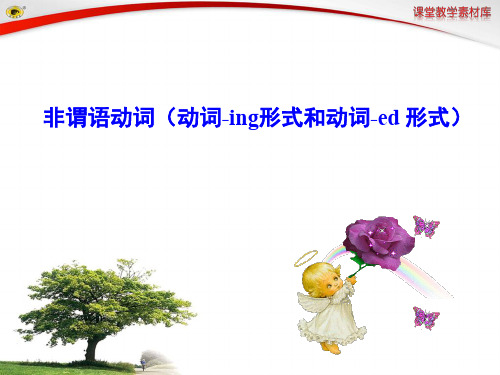
7.心理状态动词的-ing形式与-ed形式 所谓心理状态动词是指含有使动意义,使人产生某种情
感、心理变化的动词。例如:surprise使惊讶;interest使感 兴趣。它们的-ing形式含主动意义,-ed形式含被动意义。 皆可视为形容词。例如:surprising令人惊讶的;interesting 令 人 感 兴 趣 的 ; surprised ( 因 …… ) 感 到 惊 讶 的 ; interested(因……)感兴趣的。下面的句子可显示两者的 区别: The film is so interesting that they are all interested in it. She was much surprised at the surprising news.
跟踪演练
Bill suggested ___C__ a meeting on what to do for the Shanghai
Expo during the vacation.
A. having held
B. to holdC. Nhomakorabeaolding
D. hold
【解析】选C。suggest后面要接动名词作宾语,A项是动名词
【解析】选C。encourage与主句主语many farmers之间为逻
辑上的动宾关系,因此应用被动形式,故排除B、D两项;A
项表示该动作正在进行,不符合题意;Encouraged by the
advances in technology为过去分词短语作原因状语。
v.-ing被动式与过去分词用法的区别 1. 作宾语时, v.-ing的一般被动式表示一个正在发生的被动 动作,过去分词则表示一个已发生过的被动动作或没有时间 性 的 状 态 。 例 如 : Do you see the hospital built( 建 好 的)/being built (正在建造的) there? 2. 作原因状语, v.-ing被动式与过去分词可以互换。例如: Being led(=Led )by the Party, the Chinese people have won great victories. 3. 作方式或伴随状语,不用v.-ing被动式,而用过去分词。 例如:The soldiers lay on the ground, covered with nothing.
- 1、下载文档前请自行甄别文档内容的完整性,平台不提供额外的编辑、内容补充、找答案等附加服务。
- 2、"仅部分预览"的文档,不可在线预览部分如存在完整性等问题,可反馈申请退款(可完整预览的文档不适用该条件!)。
- 3、如文档侵犯您的权益,请联系客服反馈,我们会尽快为您处理(人工客服工作时间:9:00-18:30)。
A.exhausting
C. being exhausted
B. exhausted
D. having exhausted
几个特殊的过去分词的运用: lost /given/dressed/seated lost: I can not find my lost wallet. When he came into my room , I was lost in thought. He is not understood by his friends , so he often sits alone ,feeling extremely lost given:鉴于,考虑到; 相当于 considering 指定的,规定的 Given his health, we will have to send for a doctor. Given more time , I will do the job better. We are to finish the task at the given time
The pilot asked all the passengers on board to remain _____as the plane was making a landing. (04上海春季) A. seat B. seating C. seated D. to be seating
C. Dressing
D. Having dressed
________ in the mountains for a week, the two students were finally saved by the local police (05江苏卷)
A. Having lost C. Being lost B. Lost D. Losing
are nowconvincing _________that he has committed the crime. (convince) convinced
Mr. Smith,_____ of the_____ speech, started to read a novel. (03北京春季)
in this region. (encourage) encouraging He was so _____________in this exam that his disappointing instructor was ____________.(disappoint) disappointed They were all ______________(move) by the ____________story. (touch) moved touching With so many ________evidences , the police
________ the general state of his health, it may take him a while to recover from the operation. (2000北京春季) A.Given B. To give C. Giving D. Having given _____ in a white uniform, he looks more like a cook than a doctor. (05湖南卷) A. Dressed B. To dress
A.tired; boring C.tired; bored
B.tiring; bored D.tiring; boring
六.A verb-ed can follow a verb , such as stand , sit and lie when the two actions are happening at the same time or it can be used on its own or followed by an adjective /adverbial.(伴随状语) She lay trapped under the building for three days. She lay there and was trapped .
改写:The pop-star stood there and was surrounded by his fans for half an hour. The pop-star stood surrounded by his fans for half an hour.
She left the restaurant , disappointed.
boring This is so________ a lesson that so many bored students are _______of
it. (bore) 相似动词总结: tire/disappoint/move/exciting/frustrate/touch
satisfy/amaze/convince/encourage/exhaust… …..
ห้องสมุดไป่ตู้
an interesting crosstalk 有趣的相声
Because of interesting performances given by Fenggong and Niuqun, I have become interested in crosstalk.
小结: We use verb-ing forms to describe someone/something that causes certain feelings, and they are usually active in meaning; while we use verb-ed forms to say how we feel about someone or something, and they are usually passive in meaning as they describe how someone/something is affected by an action.
She left the restaurant and was disappointed. 他度假回家,累的要死 He arrived back home from vacation, dead tired.
After his journey front abroad, Richard Jones returned home, _____
